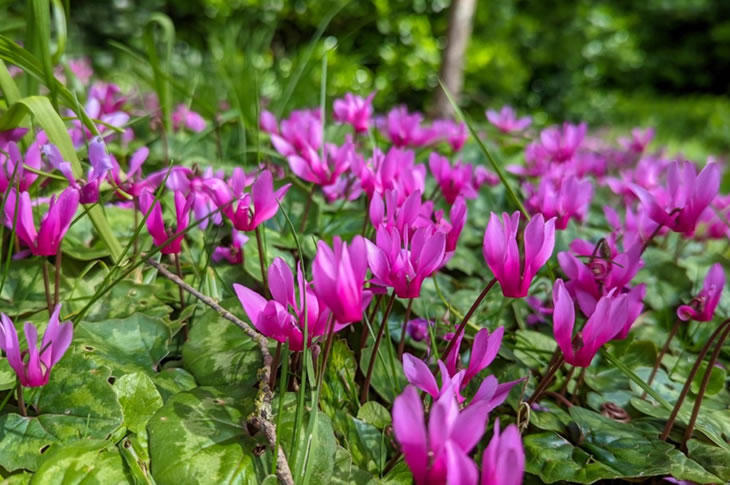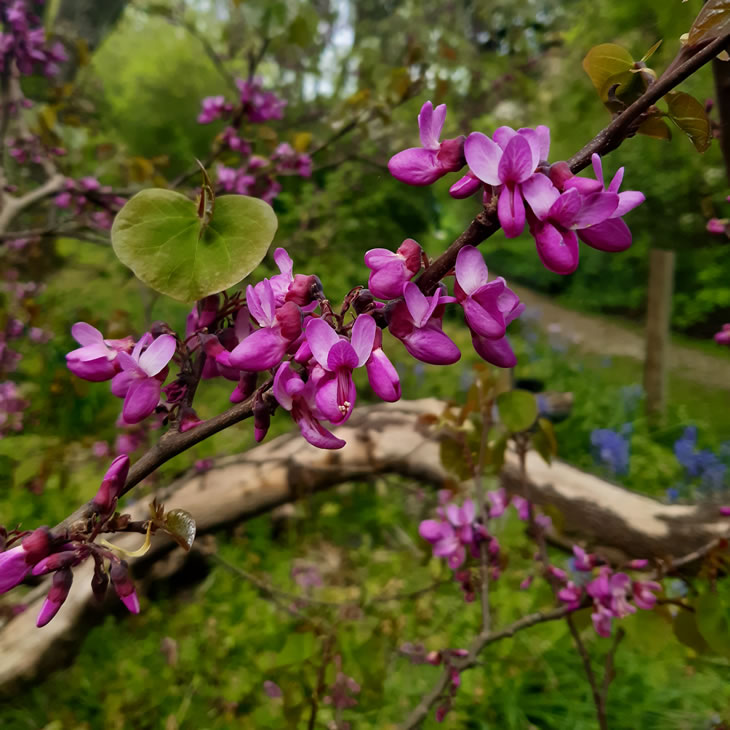For this month’s Plant Focus blog Sue takes a look at the Judas Tree – Cercis Siliquastrum.
Common Name: Judas Tree
Latin Name: Cercis siliquastrum
Garden Location: Middle Garden
Country of origin: Southern Europe and Western Asia
Hello, my name is Sue and I’ve been volunteering at Highdown Gardens for about three years. I’m entrusted to do menial tasks in these beautiful gardens such as sweeping up leaves or weeding. Plus, I’m now training to be a guide hoping to share the fascinating story of the plants and people of Highdown.
The training has been fun, with Alex (the plant expert) and Ellen (in charge of volunteers) playing good cop, bad cop … one covering us in the compost of botanical facts in the hope that our horticultural knowledge will grow and thrive and the other drilling us endlessly on the facts that we have to have at the tips of our gardening gloves for when we do the tours. Yes Ellen, we can all now recognise the gorgeous Cyclamen repandum (see photo) and spot the champion tree Chinese hornbeam (Carpinus turczaninovii) at 50 paces.
Photo of cyclamen repandum (credit: Alex New)

But there is one specimen that has caught my attention and to which I keep returning – the Judas tree (Cercis siliquastrum). What is it about this tree that I find so alluring? I think it is partly the name. It is said to be named after that most despised of Biblical characters, Judas Iscariot, one of the 12 disciples and who betrayed Jesus with a kiss, leading to his arrest and crucifixion. He is said to have hung himself from the branches of this beautiful and quirky tree. More likely, but less memorable, is that it is named after Judea, now called Israel where it can be found.
It’s unusual but not rare and a friend recalls seeing it often in Turkey, where she lived for many years. Here at Highdown, there are three or four Judas trees and in late April this year, they were at different stages of flowering depending on their position. Let’s talk about the flowers because that is the other fascinating thing about Judas – the flowers often grow directly onto old bark. Just pause to take that in because that really struck me as being unusual! Often, before the leaves develop, these little dark pink buds pop up straight onto the bark. If you know of any other trees where this happens, please let me know! They have a complex dark pink, pea-like flower and although I’ve not seen it yet, bear a pod-like fruit later in the year. One of the trees in the Middle Garden was absolutely covered in flowers, like a damask tablecloth.
Photo of Judas Tree flowers growing directly off of bark (credit: Ellen Mascard)

Photo of Judas Tree flowers up close (credit: Ellen Mascard)

Sir Frederick Stern recorded in his book, A Chalk Garden, that one of Highdown’s Judas trees came from Afghanistan and was given to him by the son of a fellow military man, Major Arthur Algernon Dorrien-Smith, who grew them from seed. There’s a whole other story to be told about this man, and his descendants who were Lords of the Isles of Scilly and created the world famous Tresco Gardens. Maybe another day!
One last amazing fact about the Judas Tree is that it likes to lie down as it gets older – becoming more and more prostrate so that many people think it has actually died. Now that is something I can really identify with!
Photo of Judas Tree lying down (credit: Ellen Mascard)
